I think you all know by now how big Bollywood is. Not only is the movie industry huge in India, but Bollywood movies are also screened, bought, and viewed in Indian and non-Indian communities all over the world. Even Netflix is exponentially increasing its Bollywood selection to appeal to Western audiences. (For those in the know, I realize that India’s movie industry is diverse and varied and stuffed full of languages and cultures. For the purposes of this article, when I say Bollywood, I mean any movie produced and funded in India, regardless of language. Most of the movies I reference are in Hindi, but some are not. If there are any that I missed, please comment below!)
There are obviously good and bad results of Bollywood fever, like the growing appropriation of South Asian culture in the West and the increasingly sexualized objectification of South Asian women. But I’m not here to talk to you about that. Not today, anyway.
Today I’m here to talk about queer women in Bollywood. Or rather, more precisely, the lack of queer women in Bollywood. (I am talking about queer ciswomen’s representation. Trans* representation in Bollywood is far more popular, but also so, so, so problematic. I will tackle this in a future post. Promise.)
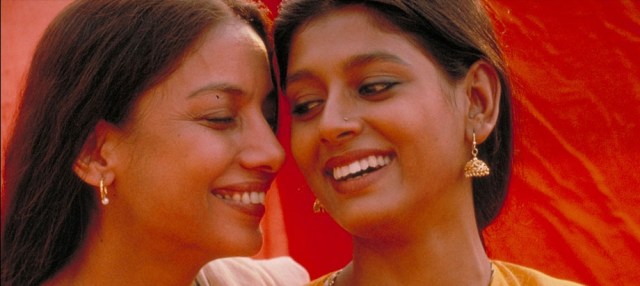
Shabana Azmi as Radha and Nandita Das as Sita in Fire
via Hamilton Mehta
There was Fire, the slow-paced family drama that attracted explosive violence in India. There was Chutney Popcorn, I Can’t Think Straight and The World Unseen. These are all British, American and Canadian films, directed by female directors based in the West and targeted toward primarily English-speaking audiences. The only thing Bollywood about these films is that they feature actresses of South Asian descent. Most of these films were not even screened in India the way that Bollywood films are screened (that is to say, in mainstream theaters to massive audiences in both rural and urban locales).
A few weeks ago, Onir wrote on DNA India about the need for more queer cinema in Bollywood. All the examples he uses, however, are male. Maybe it’s the fact that the Bollywood film industry is overwhelmingly male dominated. Or maybe it’s that the misogynist and patriarchal elements of Indian culture. Or maybe those two reasons are really just the same thing. Whatever the case, the focus in queer Bollywood has been on gay men.
In 2005, Onir released My Brother… Nikhil, set in the AIDS era about a gay man in India who tests positive for HIV, and the resulting heartache of his life.
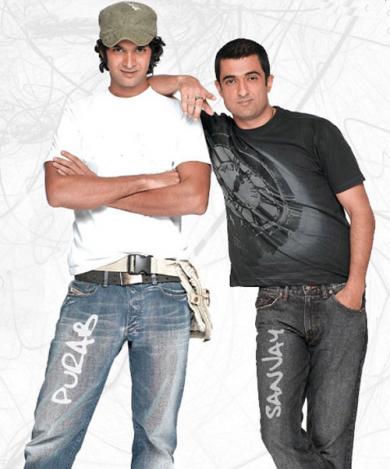
Sanjay Suri as Nikhil and Purab Kohli as Nigel in My Brother…Nikhil
via Pozor
Page 3, a mainstream Bollywood film released in the same year, features one of the first explicitly gay male characters in Indian cinema. And when I say “features,” I mean the female protagonist finds out her boyfriend is gay and sleeping with her best friend.
The 2007 film Life in a Metro also has a female character finding out that her love interest is gay.
In 2008, the Bollywood box office hit Dostana featured a gay-deception storyline where two straight men pretend to be a couple in order to sublet an apartment with a woman. Both men eventually fall in love with said woman. I Am and Bombay Talkies both tell stories of gay male violence.
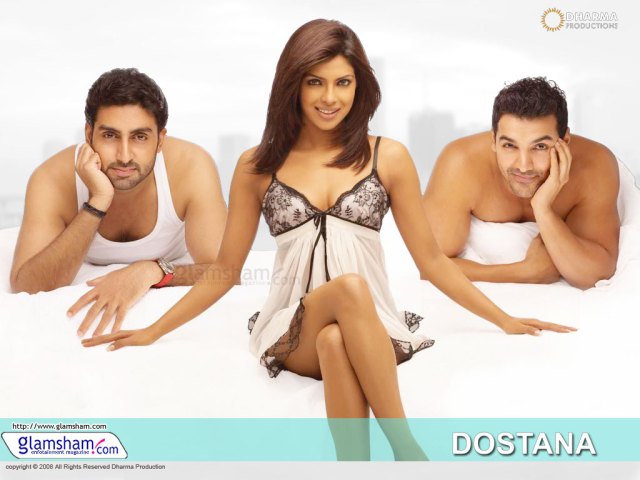
Abhishek Bachchan as Sameer, John Abraham as Kunal, and Priyanka Chopra as Neha in Dostana
via GlamSham.com
That’s six films in seven years dealing with gay men. Mostly the sad, depressing stuff of Well of Loneliness, but also raising important questions about the struggle of gay men. Where are the queer women, you ask?
The 1983 film Mandi hinted at a close relationship between the female protagonist, the madam of a brothel, and one of her prostitutes. Razia Sultan, an Urdu film released in the same year, also hinted at a lesbian coupling.
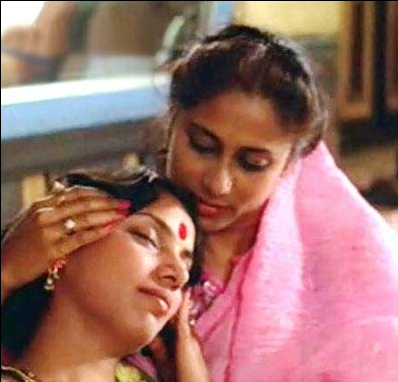
Shabana Azmi as Rukmini and Smita Patil as Zeenat in Mandi
via India Times
After a long stint of silence on the topic of queer women, Bollywood tried to take on lesbianism in the sensational film Girlfriend, released in 2004. Though controversial, the film passed the Indian Censor Board — perhaps due to its portrayal of lesbianism as male fantasy instead of a legitimate sexuality divorced from the male gaze. The phrase “male gaze” is not enough to accurately describe the thinly veiled lesbian male fantasy of the film. Tanya and Sapna are roommates and old friends from college. They are inseparable until Tanya leaves town for work. The male hero Rahul pursues Sapna and the two fall in love. Tanya returns, and jealous lesbian rage ensues as she tries to get Sapna back from Rahul’s hetero clutches. Not only does the film cast childhood sexual abuse as a cause for lesbianism, but it also features a delightfully psychotic killer “butch” who is obsessed with her object of affection. Add in the made-for-men raunch and you get a flop of a film that garnered criticism for its portrayal of lesbians.
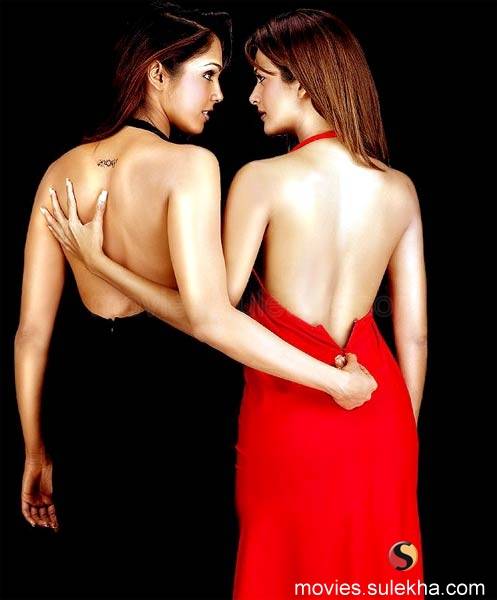
Isha Koppikar as Tanya and Amrita Arora as Sapna in Girlfriend
via Sulekha
Another iffy attempt at portraying lesbianism head on, the 2006 release Men Not Allowed features protagonists Tanya and Urmila, both of whom are fed up with men. Tanya is an advertising exec from a wealthy family. Tanya’s lesbianism is attributed to her disillusionment with the womanizing men around her (her father and boyfriend). Urmila is a model who is assigned to Tanya’s ad agency. Her lesbianism is attributed to repeated childhood sexual trauma perpetrated by an uncle (who she lived with after her drug-dealer father and addict mother die), and later by men at the orphanage that takes her in. The two become lovers and raunchy skin scenes ensue for the delight of the male audience.
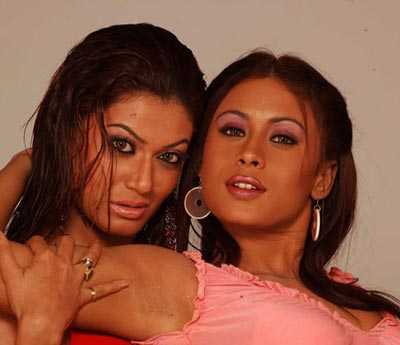
Payal Rohatgi as Tanya and Tina Mazumdar as Urmila in Men Not Allowed
via Sulekha
The 2011 thriller Shaitan featured an on-screen lesbian kiss between two of its leading ladies, one of whom is again named Tanya (don’t ask, because I don’t know). The murder film Monica, released in the same year, has homosexual overtones surrounding the female protagonist and subject.
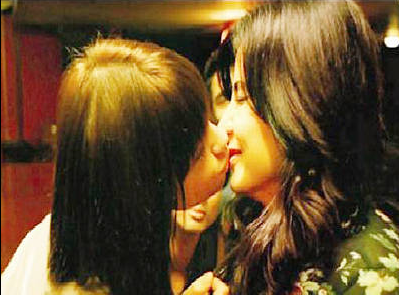
Kalki Koechlin as Amy and Kirti Kulhari as Tanya in Shaitan
via India Times
After the flop of Girlfriend and Men Not Allowed, the next film to explicitly tackle lesbian relationships came in 2012. 3 Kanya, a.k.a. Teen Kanya, is a Bengali psychological thriller that shows a lesbian flirtation (sort of) between two of its three female protagonists. It has the potential for a solid film, and none of the characters is named Tanya. Unfortunately, the plot line spins out of control, and the lesbian angle comes off as a sloppy attempt at sensationalism, or maybe just at making the story make sense, which it doesn’t. One of the women in the lesbian coupling has some sort of dissociative disorder (portrayed in a cliched, non-nuanced way), and ends up killing a bunch of people. The other half of the couple, an officer in the Indian Police Service, is super glam to a point of unbelievability.
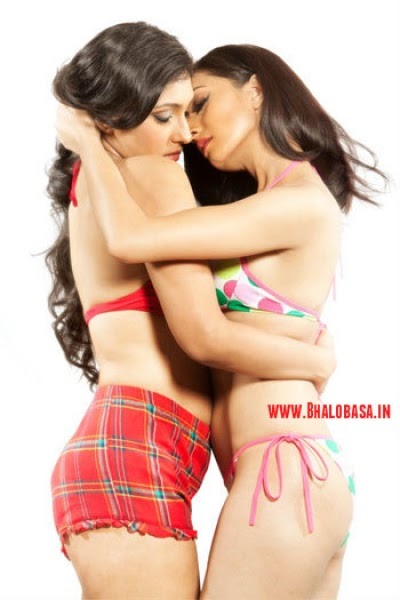
Rituparna Sengupta as Aparna and Unnati Davara as Damini in 3 Kanya
via New Bengala Movie Online
Bollywood is known for being a little campy and kitschy, though often non-ironically. These are all reasons why we love the genre. Not to mention the songs, the exotic costumes, and the dance sequences that are now taught to white people in absurdly expensive classes at local yoga studios everywhere. But when it comes to queerness, and queer women in particular, the male-dominated industry sweeps aside the real stories of queer women in favor of sensational lesbian male fantasies and 1950s-lesbian-pulp-fiction-esque tropes of psychotic murderers and sexually traumatized queer roots.
One of the critiques leveled at calls for better portrayals of queer people in Indian film is the idea that queerness is a Western invention. While queerness has a recorded and folk history in South Asia, history and culture taught in schools is washed clean of all queer content thanks to the British colonialist values that founded and continue to guide most of India’s education system. For more information, check out Giti Thandi’s Sakhiyani: Lesbian Desire in Ancient and Modern India.
We can do better than this. I love Bollywood (or at least, I used to love it) too much to accept that this is as good as it gets. After India’s landmark 2009 decision to decriminalize homosexuality under its Section 377 Penal Code, the Indian Censor Board has less legal backing to shoot down queer stories. Queer rights visibility is on the rise in South Asia. The time is ripe for some fresh, realistic portrayals of queerness in Bollywood. And while we have plenty of men in the business to give some better perspective and humanization to gay men, getting more women into Bollywood (especially into non-acting roles) is an essential step in better lesbian representation.



Thanks for this, it was really interesting. Would you happen to know anything about the queer Indian diaspora outside of US/UK/Canada as it pertains to film?
[Sort of tangentially…colonial-era legislation and its sometimes vigorous defence/retention by post-colonial societies is really hard to negotiate. Like…it could help if folk/indigenous/other ‘older’ traditions have different views of gender and sexuality, as a demonstration that configurations of gender/sexuality/sexual orientation aren’t universal. But those can’t be the only or the most important argument we use. Where I’m from, I’m not sure traditionalist/folk alternative narratives exist for queer sexuality (gender is probably a different story), and if they do, activists don’t publicly use them.]
I wish I did! I’m not familiar with South Asian queer diaspora in non-English speaking countries. Though it would be very interesting to see what happens.
As a Malaysian queermo of Bangladeshi parentage – they are there, but I think a lot of them wouldn’t identify first with being South Asian. For instance, I’d wager that Malaysian South Asians (mostly Indians of Tamil background, but not exclusively – and then you get into the whole Other/Lain-Lain brouhaha) identify themselves as Malaysian first and foremost. South-East Asian rather than South Asian.
But then you go elsewhere and people think of SEA as Vietnam, Thailand, Cambodia, Philippines. Malaysia, Singapore, Indonesia, Brunei all oddities.
At DesiQ (conference for queer South Asians and diaspora that was in SF recently) I ran into one other person from Malaysia, as well as someone who’s American but whose parents were from Malaysia and Singapore. They all had some difficulty with “desi” or “South Asian” as descriptors because those tend to assume some sort of cultural experience that they didn’t share.
This was a really interesting article. I love seeing stuff like this on AS! I am constantly searching for good foreign films that have lesbian romances or plotlines outside of the usual tropes – they are so hard to find. I really hope more woman have the opportunity to be involved in the Bollywood film industry!! It’s about time.
women*
Totally off topic, but Dostana was a pretty great movie!
Back on topic, I think the lack of portrayals of alternate sexualities has less to do with those who write the scripts and more to do with the audience it’s being presented to. While I’m sure there are a gazillion reasons that contribute to it, one of the biggest has got to be the marrige system. Arranged marriages are really widespread, and most women, at least, are brought up with the idea that after a certain age, they’ll get married to a nice engineer/doctor guy chosen by the parents and go make a family. At least here, in high school or college, you get the option to finally explore and choose your identity. There, it’s pretty much handed to you. So, if the audience is born with the idea of a guy/girl pairing, which director would waste money trying to convince them otherwise?
This was a really fascinating article! I can’t wait for more queer analysis on Bollywood and South Asian countries.
Very interesting!
Especially interesting to read after watching I Can’t Think Straight the other night!
Have you seen “The Journey”? I think it might have been Tamil, not sure. Anyway it was restrained, but the two women in the story were the whole story, and it got a lot of critical acclaim…
I wonder how much of this is the idea that women don’t really have much agency at all. How can they be interested in anything besides men?! Hell, how can women have any sort of sexuality whatsoever?! Any hint of interest means that they are no longer pious or pure, but instead are trampy or slutty or degrading or whatever. Doesn’t really take much to be considered a ‘slut’ back home.
I was reading up about rekhti some time ago – supposedly historical Urdu poetry about women’s loves written by men. Already I wonder how much of this is sensationalistic.
Delhi is a center of delights for fun lovers and for those who want to enjoy each and every moment of life. If are you planning for a holiday celebration around Delhi then you have reached the very right place. ResortsNearDelhi.co.in, a Division of ‘COMFORT YOUR JOURNEY PVT LTD’ avails you the options for Weekend Getaways Near Delhi.
visit: http://www.bestholidaystrip.com/